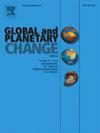Millennial-scale East Asian summer monsoon hydroclimate variability during 47–39 kyr B.P. inferred from a stalagmite IRMsoft-flux record in Southeastern China
IF 4
1区 地球科学
Q1 GEOGRAPHY, PHYSICAL
引用次数: 0
Abstract
The East Asian Summer Monsoon (EASM) exhibited millennial-scale oscillations during the Last Glacial Period, characterized by alternating cold stadials and warm interstadials that were broadly synchronous with climate changes in the North Atlantic. However, the mechanism linking regional hydroclimate variability to high- and low-latitude forcing remains debated. Here, we present precisely dated speleothem multi-proxy records, including δ18O, δ13C, and an environmental magnetic proxy (IRMsoft-flux), spanning 46.92–39.18 kyr B.P. from Xianyun Cave, southeastern China. The IRMsoft-flux, serves as an indicator of precipitation intensity, revealing increases during Dansgaard-Oeschger (DO) events 12 and 11, consistent with enhanced water vapor influx into southern China. Maximum moisture availability occurred between 43.96 and 42.98 kyr B.P., encompassing the DO 11 event and a weak monsoon interval, as corroborated by concurrent δ13C depletion, enhanced growth rate, and high initial 234U/238U ratio. This period of increased hydrological activity coincides with the peak of the half-precession cycle, which influences the vertical temperature gradient in the equatorial western Pacific, as well as the minima of west-east sea surface temperature gradient (ΔSST) in the equatorial Pacific. During this El Niño-like state, a weakened East Asia Hadley circulation (EAHC) and a southward shift of the Western Pacific Subtropical High (WPSH) amplified moisture convergence over southern China. Our findings demonstrate that the thermocline variability in the tropical Pacific, propagated hydroclimatic signals to subtropical East Asia via ocean-atmosphere circulation coupling, particularly affecting regions near the water vapor source from tropical Pacific.
基于中国东南部石笋irmsoft通量记录的47 - 39kyr B.P.千禧年东亚夏季风水文气候变率
末次冰期东亚夏季风(EASM)表现出千禧年尺度的振荡特征,表现为冷间冰期和暖间冰期交替,与北大西洋气候变化大致同步。然而,将区域水文气候变率与高纬度和低纬度强迫联系起来的机制仍存在争议。本文对中国仙云洞46.92 ~ 39.18 kyr B.P.范围内的δ18O、δ13C和环境磁代理(irmsoftware -flux)进行了精确测年。irmsoft通量作为降水强度的一个指标,显示在Dansgaard-Oeschger (DO)事件12和11期间降水强度增加,与华南水汽涌入增强相一致。最大水分有效度发生在43.96 ~ 42.98 kyr b.p.之间,包括DO 11事件和弱季风期,同时δ13C耗竭,生长速率增强,初始234U/238U比值高。这一水文活动增加的时期与半岁差周期的高峰重合,影响赤道西太平洋的垂直温度梯度,也影响赤道太平洋东西海面温度梯度的最小值(ΔSST)。在这次El Niño-like状态中,减弱的东亚哈德利环流(EAHC)和西太平洋副热带高压(WPSH)向南移动增强了中国南部的水汽辐合。研究结果表明,热带太平洋的温跃层变率通过海洋-大气环流耦合将水文气候信号传播到亚热带东亚,特别是影响热带太平洋水汽源附近地区。
本文章由计算机程序翻译,如有差异,请以英文原文为准。
求助全文
约1分钟内获得全文
求助全文
来源期刊

Global and Planetary Change
地学天文-地球科学综合
CiteScore
7.40
自引率
10.30%
发文量
226
审稿时长
63 days
期刊介绍:
The objective of the journal Global and Planetary Change is to provide a multi-disciplinary overview of the processes taking place in the Earth System and involved in planetary change over time. The journal focuses on records of the past and current state of the earth system, and future scenarios , and their link to global environmental change. Regional or process-oriented studies are welcome if they discuss global implications. Topics include, but are not limited to, changes in the dynamics and composition of the atmosphere, oceans and cryosphere, as well as climate change, sea level variation, observations/modelling of Earth processes from deep to (near-)surface and their coupling, global ecology, biogeography and the resilience/thresholds in ecosystems.
Key criteria for the consideration of manuscripts are (a) the relevance for the global scientific community and/or (b) the wider implications for global scale problems, preferably combined with (c) having a significance beyond a single discipline. A clear focus on key processes associated with planetary scale change is strongly encouraged.
Manuscripts can be submitted as either research contributions or as a review article. Every effort should be made towards the presentation of research outcomes in an understandable way for a broad readership.
 求助内容:
求助内容: 应助结果提醒方式:
应助结果提醒方式:


